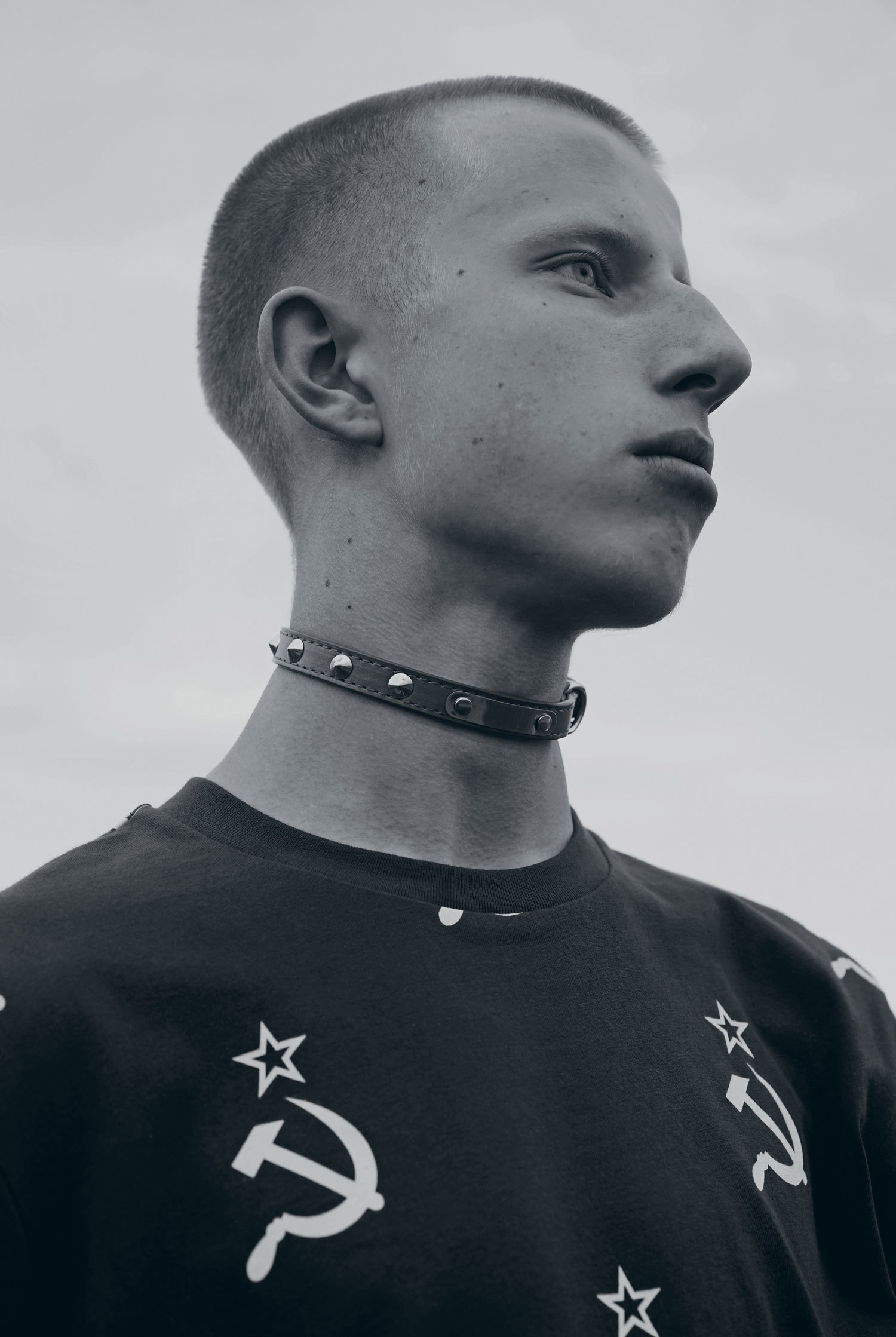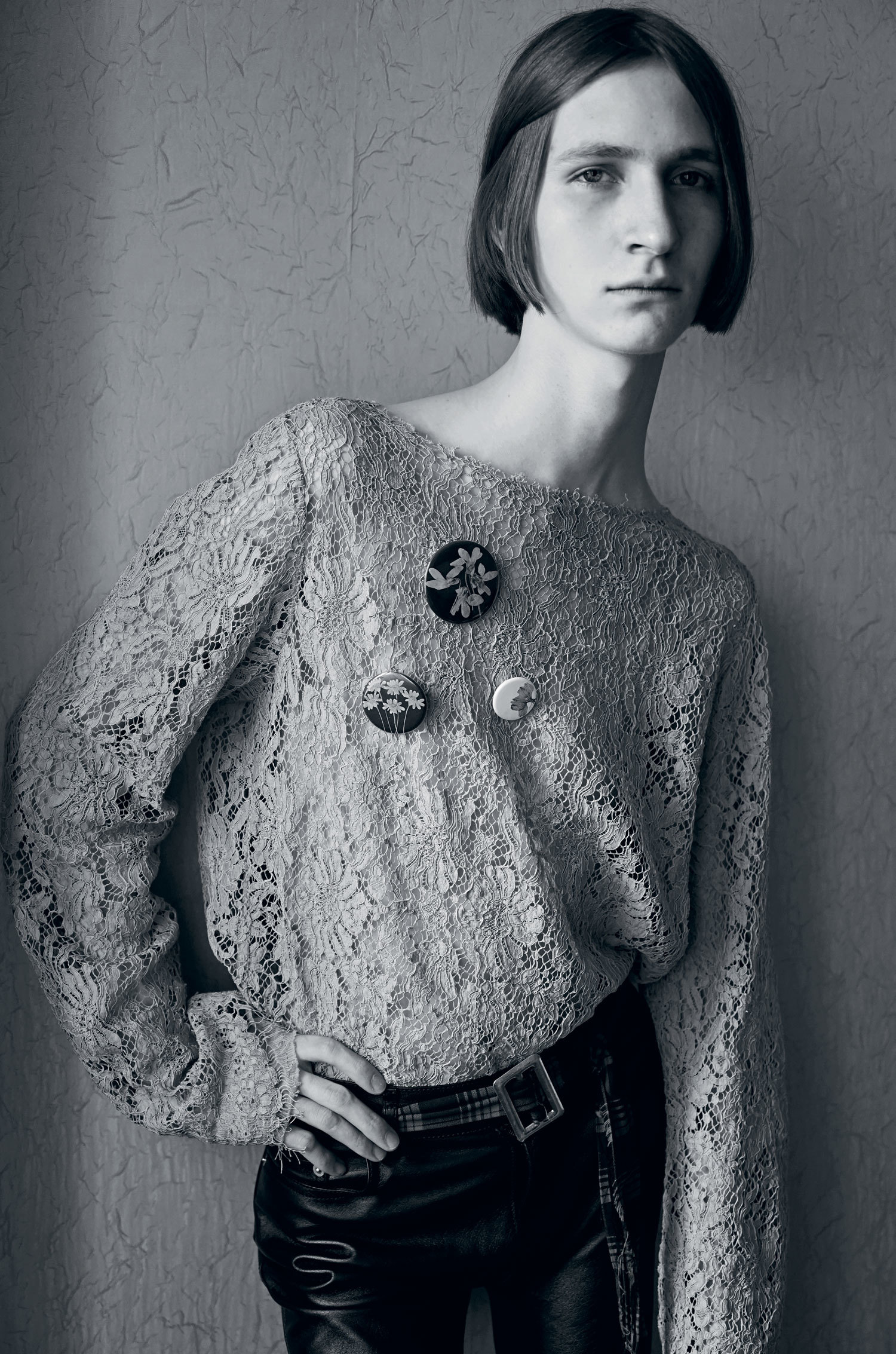What Type of Fashion Is Rubchinskiy Credited to Bringing to the Mainstream
Dry out wears jumper Gucci. Collar stylist's own.
"It's about Moscow now and how they dress there. It's about boys - the boys who come up to the parties, the ten boys from Moscow, they're real and we had to bring them to Paris," says Gosha as the distorted sounds of Buttechno echo backstage. Seduced past the sweat, smiles, synth and sheer sexual practice of Moscow's youth for spring/summertime 16, Gosha transported us to the dancefloors of his favorite tech-club, NII. With its 1984 logos, remixed Rodchenko and Iron Mantle-stitched sportswear, the collection was undoubtedly lit with nostalgia, but Gosha wasn't looking back. It was just the latest peek inside his reality -- a reality that is intriguing largely because Russia is an unfamiliar entity, but at the same time has a universal coming of historic period appeal. Ultimately, he depicts an irresistible duality of youth that is both fresh and familiar.
Slowly only surely, from his Evil Empire debut to his explorations of the Nazbol football hooligans of fall/winter 15, Gosha has been filling in the gaps of the post-Soviet underground. Mainstream media coverage of modern Russia largely centers effectually the excess of oligarchs and supermodels. Placing his lens over his reality, Gosha has opened the world'south eye to a Moscovite underbelly we would non have encountered otherwise. And whether consciously or not, through the mediums of fashion, motion-picture show and photography, his work tin be interpreted as a reaction to Russia'southward shifting socio-economical values. "Last year, during the economical crisis, rent in Moscow became cheaper and young people started to open their own places; new bars and clubs opened. One of these places is NII, a techno identify where DIY musicians play -- and they are the owners too. It was and still is, ane of the hype places in Moscow," he explains excitedly over a crackling Skype connectedness.

Sever wears T-shirt Gosha Rubchinskiy. Collar stylist'south own.
As a lensman, filmmaker and fashion designer, Gosha is a rare breed -- a multi-disciplinary storyteller who lifts the lid on Russia's underground to build upwardly the picture of disaffected youth. Right from the very outset, Gosha was interested in his grouping of friends - skateboarders - and their world. "About ten years ago, skateboarding emerged as one of the primary subcultures for Russia'south youth and I've looked to it e'er since," he says. "I was drawn to this new energy. I started hanging with this group, spent all my time with them. We skated, we partied, took trips to other cities. It was a special time, one in which I took many photos and shot a number of videos. I needed to do something to capture the energy. I needed to share it."
Information technology's a globe that has seduced legions of fanboys (and girls), who have bought into Gosha, not only as a make, but equally a cultural opinion leader, too. From designing for a growing group of friends, his work soon spread through Moscow, St. Petersburg and beyond. Fast forrad to today and his designs fly off the shelves in London, New York and Stockholm. "It's crazy when nosotros receive a new drop from Gosha, everything sells then fast," says Stavros Karelis, founder and buying director of MACHINE-A. Correct now, the same kids who collect, covet and queue for the likes of Supreme and Palace want Gosha Rubchinskiy. Why? The appeal of Gosha'southward clothes can be seen as a sort of quasi-exotification of Russia, its otherness and relative unfamiliarity. In that location's an element of cultural voyeurism, a feeling that we'll never truly witness or understand Gosha's Russia, simply nosotros want to exist a part of the feel.

Mak wears top Gucci. Trousers Saint Laurent by Hedi Slimane. Belt model's own. Badges Dior Homme.
The other side of the story, that we can understand, is the teenage experience. From first times to first loves to first fuck-ups, growing up unites us. "I tin can't exist sure because I'k not a teenager, but from my optics it appears that being a teenager is the same almost everywhere," says Gosha. "It's the same in the US, the UK, Prc and Russian federation, because of the internet. You can listen to the same music, wear the same clothes, fifty-fifty get to the same parties."
Over the lifetime of his various projects, his group of boys have shape-shifted, morphed and matured before his eyes and lens. "It's interesting to see how people grow and what they do," he says. "Some have get musicians, others artists, and if their work is interesting, I desire to work with them. At times I feel like a teacher - information technology's interesting. Merely ultimately, I'm e'er learning from them." Gosha has become the pied piper of the Russian underground and people are approaching him, post-obit his atomic number 82. They might brainstorm life as subjects, but through friendship and artistic collaboration, they're oftentimes drawn deeper into his all-encompassing world. "I made DIY fanzines with one of the early skaters, Pavel, and now he'southward producing techno and works on our soundtracks," he says. "Some of us have grown up together and some are new. Some are ten years old. In the last evidence peculiarly, we looked to the new generation, but they're all inspiring."
From hearing pleas to interact to searching for the perfect bandage, Gosha has learned to harness the power of social media. The boys in this shoot were all found online. "I don't savour using agencies. I like to exercise the work," he says. "Equally always with Lotta [Volkova, who styled this story], we wanted to show interesting characters, and then I started looking for boys, searching Instagram and exploring friends of friends." I boy was so desperate to exist part of Gosha'south earth that he travelled on the train for two days from Siberia to Moscow. "I didn't know where he was based, but he was cute. I just messaged him and he was upwards for it. It was perfect. Other boys came from different cities. I e'er similar to use someone special. On one of the final days, we went to a bar and found Mak. He was the last we shot. He came the next morning but he hadn't slept. He's a musician and he'd spent all night in his home-studio, recording."
The effect is a shoot that picks up where the narrative of spring/summertime 16 left off and his adjacent projection promises to delve deeper still. Over the last two seasons, whenever Lotta has been over for shoots she has stayed in the aptly named, Youth Hotel. "It was built for the Moscow Olympics, it's very absurd, so cute," explains Gosha. "Later on shoots we go to bars and and then go back to the hotel because it'southward cheap, tranquility and nosotros tin do later on-parties inside. I've taken a few pictures in and around the rooms and we're planning on releasing a book in October." What will tomorrow bring? Not even Gosha knows, but where he goes, we'll follow.
@gosharubchinskiy
Credits
Text Steve Salter
Photography Gosha Rubchinskiy
Styling Lotta Volkova
Models Sever and Dry at Lumpen Moscow. Mak Blueish.
0 Response to "What Type of Fashion Is Rubchinskiy Credited to Bringing to the Mainstream"
Post a Comment